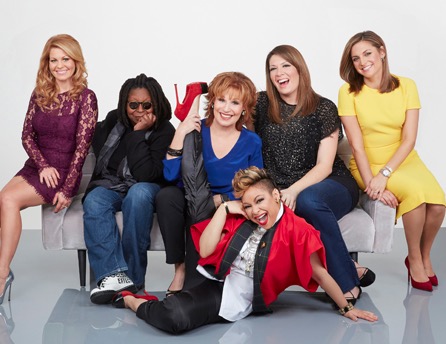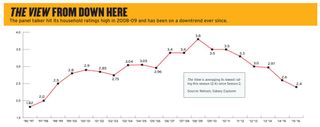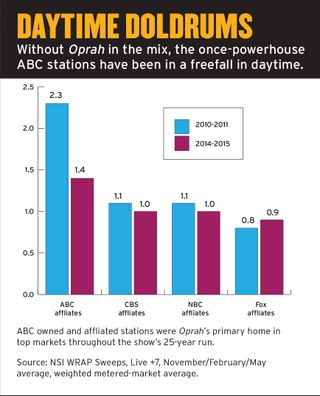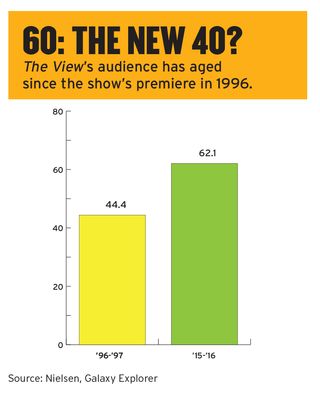How to Value ‘The View’

Updated Monday, Dec. 11, 2015 at 11:28 am PT, correcting the spelling of executive producer Brian Teta's last name, which was spelled Tata in the original version.
ABC’s The Viewcame under fire last September when its hosts at the time—Whoopi Goldberg, Joy Behar, Michelle Collins, Paula Faris and Raven-Symoné—mocked Miss USA contestant Kelley Johnson. For her talent portion, Miss Colorado had veered from the baton-twirling norms of beauty pageants by donning her nurse’s uniform and delivering a monologue about the rewards of nursing.
“She came in in a nurse’s uniform, and basically read her emails out loud,” hooted Collins. Added Behar, “Why does she have a doctor’s stethoscope on?”
Both later apologized, with Behar acknowledging, “I didn’t know what the hell I was talking about.” But the mea culpas came too late. Advertisers including Johnson & Johnson and England’s Best Eggs were pulling out of the show in very public fashion.
Weeks after that dustup, the show made news again in November when the hosts joked about eating disorders. “Please know that while this is in jest, as someone that has dealt with an eating disorder, I don’t want to make light of anyone that has it,” said host Cameron Candace Bure, who joined the show a little later this season, after completing taping of Fuller House for Netflix. “We keep getting into trouble on this show,” marveled Behar. “We upset some people. We understand that bulimia is a serious illness. We’re just trying to have some fun over here.”
Trouble has been The View’s middle name, not just this fall but for the past several years. With a fast-revolving door full of hosts, ratings erosion and media outlets and social media snipers seizing on every faux pas, TV business observers routinely wonder if the show is nearing its expiration date. While a paradigm-shifter and cultural agenda-setter when it arrived in the 1990s, the show has lately served more as an easy piñata for its tendency to offend and its soap-operatic levels of backstage drama.
And yet, in a fragmented TV landscape, the ABC property has managed to remain steadily profitable, its stakeholders assert to B&C.
Broadcasting & Cable Newsletter
The smarter way to stay on top of broadcasting and cable industry. Sign up below
“There’s a tremendous amount of equity in this brand,” said Hilary Estey McLoughlin, a veteran daytime programmer who came on board The View in August as executive consultant.
That means winding down the show would be far riskier than staying the course. What’s more, after 19 years on the air—making it the fourth-longest running talk show in television history behind only Live With Kelly and Michael, The Phil Donahue Show and The Oprah Winfrey Show—Disney-ABC’s grandmother of panel talk shows has become more settled than ever behind the scenes. And on-air, it still generates buzz, headlines and controversy. In this age of “peak TV,” breaking through the clutter is about the most you can ask of any program.
Constant Drama
The show’s fate seemed shaky after it experienced a cascade of changes that started in March 2013 when rumors began swirling that Elisabeth Hasselbeck would be leaving the show. The conservative Hasselbeck’s frequent political spats with Rosie O’Donnell, who did her first tour on the show from 2006 to 2007, kept The View in the news and drove up ratings.
One of their most famous arguments came in May 2007 after O’Donnell said: “655,000 Iraqi civilians dead. Who are the terrorists?…If you were in Iraq and another country, the United States, the richest in the world, invaded your country and killed 655,000 of your citizens, what would you call us?”
Hasselbeck backed away from defending O’Donnell, saying “Defend your own insinuations.”
In May 2013, Hasselbeck decamped for Fox News, which she just left last month. Since she’s been at Fox News, Hasselbeck has continued to tussle with O’Donnell on social media.
Jenny McCarthy was brought in to replace Hasselbeck, but only lasted a season. McCarthy told Howard Stern last March that she couldn’t be as outspoken on the show as she would have liked. In the years before she joined the show and while she was on the show, she frequently came under criticism for claiming that autism is caused by vaccinations. (McCarthy has repeatedly said in recent years that she is not “anti-vaccine,” but that parents should do their homework when it comes to their kids’ diagnoses.)
Behar, who had been with the show from the beginning, also left in 2013.
The biggest departure, however, was that of show creator and executive producer Barbara Walters, who announced in May 2013 that she would retire from being one of the show’s regular on-air panelists that next May. (Walters remains an executive producer on the show and occasionally makes an appearance.)
When Walters left, her cofounding executive producer, Bill Geddie, also exited. ABC brought in Bill Wolff from MSNBC to executive produce, and he in turn tilted the show even more to the political, bringing back Rosie O’Donnell and adding conservative commentator Nicolle Wallace as well as Rosie Perez. The new panel, which was put together quickly at the end of the summer of 2014, never seemed to gel. Before this season started, Wolff left to executive producer Chelsea Handler’s new talk show on Netflix, while O’Donnell, Perez and Wallace also all departed.
As the show launched Season 19, it had to again almost completely start over, for the first time building a panel of six permanent cohosts, and hiring two new executive producers in Candi Carter and Brian Teta. While The View remains in the headlines—thanks to the clicks that any tidbits, or stories like this, tend to generate—things behind the scenes, by all accounts, finally seem to have settled down.
‘Daytime Is in a Slump’
Whatever newfound sense of security has taken hold among staffers, it’s not getting easier out there for the show. Live TV viewing, apart from sports, is in decline and talk shows in particular are not widely time-shifted by viewers.
The View’s best ratings year was 2008-09, when it averaged a 3.0 in households and 3.8 million viewers. Season-to-date this year, it’s turning in its lowest performance since Season 2, averaging a 1.8 in households and 2.4 million total viewers. That’s down 10% in households since last season and down nearly 8% in viewers. The show’s ratings have declined every year since 2010-11, dropping 35% in households from a 3.0 to a 1.8 and 47% among women 25-54 from a 1.5 to a 0.8 this season.
At its peak, The View probably earned ABC approximately $75 million in annual revenue, sources tell B&C. But a key point is that even though the show’s ratings are at their lowest point in the show’s history, the show still makes money.
According to ad analytics firm SQAD, The View averaged approximately $9,000 per 30-second advertisement over the past five quarters. Assuming the show has 12 minutes of commercials per one-hour episode, that equals 24 30-second spots. Multiply that by five shows a week, and that equals $56 million in annual revenue, while sources estimate the show costs $35-$40 million to produce. Obviously, that’s a significant drop from the show’s heyday, but neither is it chump change.
It might sound like a good idea to replace a show like The View—aging, with decreasing ratings and constantly changing hosts—but unless lightning strikes, replacement shows are almost always lower rated than the shows that precede them.

“It’s been a signature show of the network for 19 years and it’s defined [ABC’s] daytime,” McLoughlin said. “The network is very committed to it, and has always been a huge supporter of the show.”
Even if ABC wanted to replace The View, it has nothing in the pipeline. It’s new syndicated debut this year, FABLife, is struggling with low ratings—it averaged a 0.7 in households and a 0.4 among women 25-54 in the week ended Nov. 15. Star and executive producer Tyra Banks is leaving the show before it’s even been on the air for one season. FABLife’s failure to launch is endemic of daytime and syndication: it’s increasingly hard to get a show off the ground and even when a show manages to do that, it can take years to grow it into a success.
ABC also doesn’t really have the option to replace The View with a syndicated show from another studio. In 2012, ABC gave back an hour of time to its affiliates to air Katie Couric’s talker in syndication, but Katie ended up being an expensive failure, with ABC owned stations in particular having to subsidize it with very high license fees. ABC pulled the show after two seasons.
“Katie was a colossal disaster on an epic level,” said a TV station executive. “Until ABC comes up with something else to replace The View, they will keep it on the air. They fear that otherwise stations will do a land grab.”
And even though The View’s ratings keep sliding, it remains a consistent performer across ABC’s network and syndicated daytime schedule. That’s especially important considering that the ABC affiliates, including its owned stations, that aired The Oprah Winfrey Show are down 39% in daytime (between 9 a.m. and 6 p.m.) since that show went off the air in 2011.
Comparatively, CBS and NBC affiliates are down 9% and Fox affiliates, with shows including Debmar-Mercury’s Wendy Williams and Warner Bros.’ The Real and TMZ, are up 13% in daytime.
ABC used to be by far the strongest station group, averaging a 2.3 among women 25-54 across its affiliates in 2011, but by the end of last season that number had dropped to a 1.4. ABC is still the top affiliate group in daytime, followed by CBS and NBC at a 1.0 each and Fox at a 0.9, but it has lost a lot of ground.
“Daytime is in a slump. The late morning through the early afternoon have become, generally speaking, kind of lackluster,” said the station executive.
The Big Makeover
Given the option of keeping it or replacing it, ABC is clearly choosing to back The View. It’s also working hard to boost the show’s ratings and bring viewers back, whether that’s by creating a more stable panel with whom viewers want to spend time, emphasizing the live element of the show or getting much more social.

At the start of this season, The View expanded to five days a week, shooting live to tape on each day. That allows the show to take on the topics of the day every day, something that’s become essential in daytime.
“It’s been great to be much more current on Fridays,” said McLoughlin. “This show is driven by being as topical as possible. Because we have the luxury of being live, we are really tapping into the audience. People are tweeting in and we are engaging viewers on Facebook.”
“Here’s what’s very cool about being live: People don’t know what’s going to happen. Something could actually go wrong,” said Carter, who’s currently serving as a consulting producer on the show, but is likely to stick around for a while. “If you remind people that you are live, it’s exciting for them. That’s also what makes our Hot Topics exciting at the start of the show. I love it because now we don’t have to be so clean and neat anymore. We can show people in their dressing rooms, or walking down the back hall.”
Almost more than in any other daypart, daytime talk shows are made or broken based on the relationship their hosts have with their audiences. The last two seasons of host-swapping has been difficult for The View because audiences haven’t had a chance to get to know anyone before they move on. Creating that stability is a priority for McLoughlin.
“We have really been focusing on stability and trying to focus on the panel who is there every day,” she said. The show has brought in many different experts to discuss topics in their areas of expertise, but these contributors, while adding a fun element, are not the show’s focus. “We want to cement that relationship with the audience.”
Part of creating that stability was bringing back Behar. “When I first got here, the one thing that people always said was that they missed Joy. She checks all the boxes: she’s really smart, funny, informed and she has a very young sensibility. She was like having an old friend come back,” said McLoughlin.
“It’s a very hard show to do,” McLoughlin continued. “There’s not a lot of people who can do this show. You have to be smart, interesting and a great storyteller. You have to have a sense of humor while being able to listen to and interact with other people. There are so many different facets to it.”
Making the show more social also has been a priority. This year, it launched “After the View,” which is a behind-the-scenes show that is shot two days a week after taping is done and airs online. “Our mandate is to create a 360-degree show,” said McLoughlin.
The show also is focusing heavily on politics, which seems to be a boon in this political-heavy year. It’s had many candidates—including Sen. Bernie Sanders, a clip of whom hit 1.8 million views online—visit the show.
“Politics is just part of the core of the show,” said Carter. “It would be remiss in this very exciting political season to not be a part of it. It’s about being relevant, being part of the conversation. Its all part of our overall intention.”

Having those political conversations definitely creates opportunities for controversy, but The View has never shied away from that.
“I think that’s always been a hallmark of the show,” said McLoughlin. “Controversial things happen but it’s always very organic. It’s not like we sit down and say we’re going to go out there and make some noise. The only thing we ever do is respond to things in real time, which I think is our show’s appeal.”
“Our philosophy is that The View is a place to be heard,” said Carter. “I’ve talked to Barbara [Walters] a lot about this and that really gets the show focused back on its original intention. This is really a place to be heard and let other people be heard.”
Contributing editor Paige Albiniak has been covering the business of television for more than 25 years. She is a longtime contributor to Next TV, Broadcasting + Cable and Multichannel News. She concurrently serves as editorial director for The Global Entertainment Marketing Academy of Arts & Sciences (G.E.M.A.). She has written for such publications as TVNewsCheck, The New York Post, Variety, CBS Watch and more. Albiniak was B+C’s Los Angeles bureau chief from September 2002 to 2004, and an associate editor covering Congress and lobbying for the magazine in Washington, D.C., from January 1997 - September 2002.










